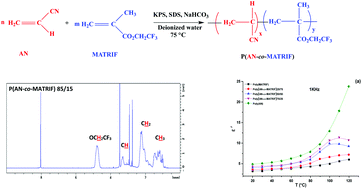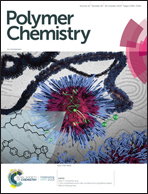Preparation and dielectric properties of poly(acrylonitrile-co-2,2,2-trifluoroethyl methacrylate) materials via radical emulsion copolymerization†
Abstract
Radical emulsion copolymerization of acrylonitrile (AN) with 2,2,2-trifluoroethyl methacrylate (MATRIF) and their homopolymerization initiated by potassium persulfate (KPS) were studied. The resulting P(AN-co-MATRIF) copolymers were characterized by 1H, 13C NMR and IR spectroscopies and their compositions were determined by 1H NMR. The kinetics of radical copolymerization of AN with MATRIF was investigated from several experiments achieved at 75 °C from initial [AN]0 : [MATRIF]0molar ratios ranging between 15/85 and 85/15. The extended Kelen–Tüdos law enabled one to assess the reactivity ratios of both comonomers (r1 = rAN = 0.09, r2 = rMATRIF = 0.47 at 75 °C). Their product, r1 × r2 = 0.04 close to zero, anticipates a certain tendency to an alternated structure for the P(AN-co-MATRIF) copolymer with homosequences based on both monomers depending on their molar feed compositions. This was also confirmed by Igarashi's and Pyun's laws which revealed the presence of AN-MATRIF, AN-AN, and MATRIF-MATRIF dyads. The glass transition temperature values, Tg, of these copolymers showed a slight increase from 75 to 78 °C as the MATRIF molar percentage decreased from 82 to 34 mol% in the copolymer. Dynamic mechanical analysis (DMA) thermograms of the P(AN-co-MATRIF) 75/25 copolymer (where 75 and 25 are the feed molar percentages of AN and MATRIF, respectively) showed a second broad signal attributed to the local relaxation corresponding to the homosequences. Both P(AN-co-MATRIF) copolymer films were dielectrically characterized over a frequency range between 20 Hz and 1 MHz, and from 20 to 120 °C, further compared to the corresponding PMATRIF homopolymer. The dominating relaxation process detected in both materials is the α-relaxation, associated with the dynamic glass transition. The dielectric increment, Δε, and dielectric breakdown, Eb, were calculated while the composition of AN in the copolymers (and polarity)–permittivity relationship was established. Therefore, the adopted synthesis strategy can tailor the dielectric properties of copolymers by changing the monomer feed ratios with suitable film formation. This improvement in dielectric properties was observed when the composition of AN was higher in the copolymers and therefore opened new applications of thin films made of P(AN-co-MATRIF) copolymers for energy capacitor devices of amorphous copolymers.



 Please wait while we load your content...
Please wait while we load your content...